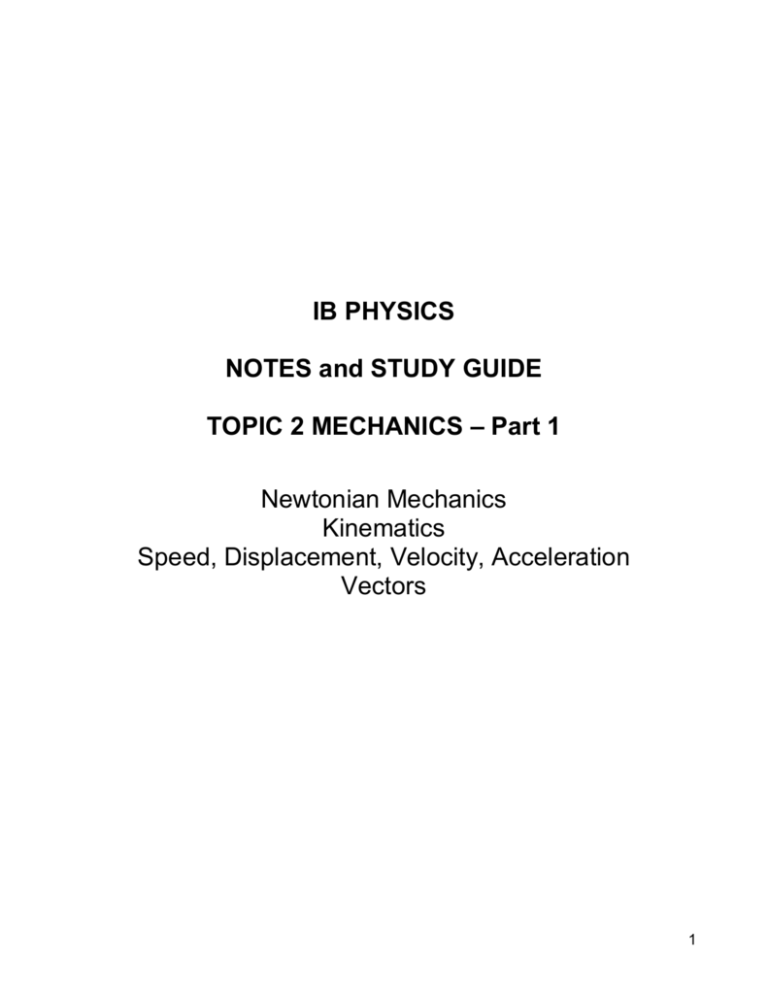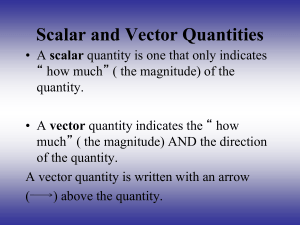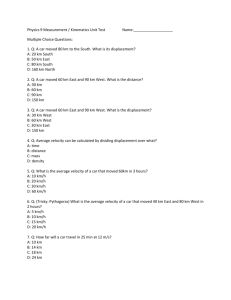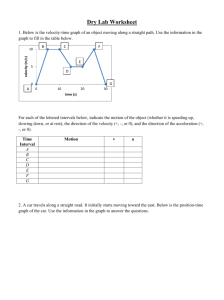Distance, Displacement, Speed and Velocity
advertisement

IB PHYSICS NOTES and STUDY GUIDE TOPIC 2 MECHANICS – Part 1 Newtonian Mechanics Kinematics Speed, Displacement, Velocity, Acceleration Vectors 1 1. CHAPTER 2 KINEMATICS : Distance, Displacement, Speed and Velocity Data booklet Formulas s = displacement or distance also called Δ x but we will use s s0 = initial displacement or distance; u = initial velocity t = time a = acceleration Distance ( s) and Displacement ( Δ s also called Δ x) IB can be confusing and many times they interchange the symbols for distance and displacement. You will need to read each problem carefully to make sure you know what they are asking for. Distance is a scalar ( magnitude only) quantity and is the total distance of the path taken and depends on the path taken. Displacement is vector quantity ( direction and magnitude) and is a measure of the net distance traveled and does not depend on the path taken. Scalar quantities only measure magnitude. For example: You are going 40 km/ h. Vector quantities have both magnitude (“how much” or “how big”) and direction . For example : You are going east at 40 km/h. 1. A jogger jogs from one end to the other of a straight 300 –m track ( from point A to point B) in and then turns around and jogs 100m back toward the starting point ( to point C). A_____________________________________C________________B 200m 100m A) What is the jogger´s distance going from A to B and then back to C ? B) what is the jogger´s displacement in going from A to B and then back to C? 2 2. What is the distance of a car that travels half a lap along a circle that has a radius of 150 m? what is the displacement? Circumference = 2 π r What is the displacement of the car that travels a full lap? Speed and Velocity A word on notation Speed is a scalar quantity and equal to total distance over time : v = s t Velocity is a vector quantity and equals total displacement over time : v = Δ s Δt Example : The jogger runs from one end to the other of a straight 300 –m track ( from point A to point B) and then turns around and jogs 100m back toward the starting point ( to point C) . It takes 40 s to do this. A_____________________________________C________________B 200m 100m A) What is the jogger´s average speed in going from A to C ? B) What is the jogger´s average velocity in going from A to C ? 3 IB Examples : 1. Samantha walks along a horizontal path in the direction shown. The curved part of the path is a semi-circle. The magnitude of her displacement from point P to point Q is approximately A. 2 m. B. 4 m. C. 6 m. D. 8 m. 2. Which of the following may be determined from a speed-time graph? A. Displacement B. Distance C. Power D. Force 4 Text Tsokos p. 39 : Q1 – Q3 draw also. p. 41 : Q5 – Q10 Formulas v= Δs Δt s = s0 + vt 5 6 2. Graphs for Uniform Motion Text Tsokos read pp. 44-45 through fig. 1.9 Answer these questions: 1.Uniform motion is constant velocity. Describe the v-t graph of this type of motion. 2.How do you calculate the displacement from the graph in 1. above? 3.Describe what a displacement - time graph looks like for + constant velocity or uniform motion. 4. Write the equation for this graph. Explain what the slope represents 5. Compare + v to – v and what they mean in terms of direction. Velocity Time Graphs: - Constant velocity vs. Acceleration (change in velocity) - Area under a curve: rectangles vs. triangles 6 – On each graph below determine the area under the curve and what each of these areas represent. NOTE : in graph a change position to velocity on the y axis and the units to ms-1. Also note that it starts a 100 m s-1 not 0. 7 Tsokos Fig. 1.10 p. 45 : answer the following questions a) Show calculation of slope 0 to 10 s and 10 to 15 s b) Show calculation of avg. speed and avg. velocity. Why are they different? c) Calculate the displacement from 0 to 10s , 10 to 15 s , and 0 to 15 s. Text Tsokos pp. 45 – 46 : Q 15, 1-6 ( draw 6) , 7a , 8 9 Do the Following: 1.Refer to the figure below to find the distance the moving object travels between: a. t = 0 s and t = 5 s c. t = 10 s and t = 15 s b. t = 5 s and t = 10 s d. t = 0 s and t = 25 s 10 2. A) Refer to fig. below : What is the velocity at 0 s? 1 s? 2 s? B) Calculate the area under the curve between 0 and 1 s. What does this area represent? 3. Look at Figure 3 – 20 a. below. a. What kind of motion does this graph represent? b. What does the slope of the line represent? Use the intervals marked on the graph in Figure 3 – 20b to describe the velocity of the object during each interval. 11 IB Exam Questions May 2009 Exam paper 1 # 2 May 2009 Exam paper 1 # 6 12 Average Speed vs. Instantaneous speed Joseph runs along a long straight track. The variation of his speed v with time t is shown below. After 25 seconds Joseph has run 200 m. Which of the following is correct at 25 seconds? Instantaneous speed / m s–1 Average speed / m s–1 A. 8 m s–1 8 m s–1 B. 8 m s–1 10 m s–1 C. 10 m s–1 8 m s–1 D. 10 m s–1 10 m s–1 Answer : EASY : avg speed = total d/ total t = 200 / 25 = 8ms-1 . Inst. Speed = speed from graph at 25 s = 10ms-1 13 3. Scalars and Vectors Text Tsokos read p. 21 and define vector and scalar quantities. Give 2 examples of each. Vectors Scalar and Vector Quantities There are two types of quantities that are important to Physics. The first type, like a sack of potatoes only requires a number and a unit e.g. 100 potatoes. The other important quantities also have direction and cannot be described by a single number. For example to fly a plane from Guangzhou to Beijing it is not enough to simply provide to distance in kilometers from Guangzhou to Beijing as the pilot must also know the direction. Scalar quantities only measure magnitude. For example: You are going 40 km/ h. Vector quantities have both magnitude (“how much” or “how big”) and direction . For example : You are going east at 40 km/h. Examples: List as scalar or Vector 1. A person weighs 75 kg 2. A person weighing 75 kg is walking north 3. A cheetah can run 75 mi./ h 4. The policemen were chasing a thief who was headed North East at 180 km/h. 5. The distance from the house to the school is 30 miles. 6. ADD: Distance is scalar. Displacement is a vector Vector quantities cannot be added like normal numbers because it is important to also consider direction In diagrams vectors are represented by arrows, for example: is a vector line where length = magnitude and angle = direction it is always a straight line and is scaled (e.g. 1km = 1cm) Graphical Method of Vector Addition Draw scaled diagram of vectors with carefully measured angles starting with the first vector, the tail of the second vector is drawn from tip of the first vector and the tail of the third vector is drawn from tip of the second vector and so on. The resultant vector (magnitude and direction) is an arrow drawn from the tail of the first vector to the tip on the last vector. The resultant vector is equal to the displacement. 14 Vector addition triangle method . Text Tsokos p. 28 : 1 Text Tsokos p. 28 : 1 15 Vector addition parallelogram method Pythagorean Theorem can be used to determine two vectors at right angles Examples: Draw vectors ( 1cm = 1km) and determine resultant vector by a 2 + b2 = c2 Show the starting point in your drawing. 1.A car went 7 km east then 7 km north. 2. A student rode a bicycle 4 km south then 7 km west. 3. A dog walked and ended up North East 5 km from his starting point. If you know the dog walked directly east 4 km before turning north, how far did the dog have to go 16 north? Vector subtraction Tsokos Text : Read p. 24 vector subtraction : Wilson / Buffa Questions ( see at end of this section) p. 95 : 20 , 21 Tsokos p. 23 : Q3 17 Formulas for Components of a Vector . Text Tsokos read p. 25 through fig. 4.14 Vectors can be resolved into x- and y-components cos Vx V sin and Vy V therefore: Vx = V cos θ 18 Vy = V sin θ Tan θ = Vy Vx Wilson / Buffa Questions p. 96 : 31 19 Adding Components Components are added to find the resultant x-component and the resultant ycomponent [Figure 3-14 (Giancoli 2005; 51)]. Vx = V1x + V2x Vy = V1y + V2y To find the resultant vector we use the Pythagoras Theorem and trigonometry: V2 = Vx2 + Vy2 V = √(Vx2 + Vy2) Simple trigonometry can be used to calculate the x- or y-component but you must determine whether they are negative or positive based on the chosen coordinate system. Any 2 angles that are 180° different [e.g. 135° and 315° (or - 45°)] have the same tangent therefore you must sketch a diagram to see which quadrant the resultant vector 20 is in to decide the angle. Wilson / Buffa Questions : p. 96 - 97 : 34 , 37, 45 21 Tsokos p. 28 : Q9 22 Wilson / Buffa Resource Questions pp. 95 – 97 23 24 25 4. Relative Motion in a Straight Line – Frames of Reference Relative Motion In a Straight Line RELATIVE VELOCITY Example 1 : Read text below about the train and observer A, B and C . Draw Original Train and relative velocities of each. NOTE when determining relative velocities always use original values. NOTE Relative Velocities – ALWAYS Subtract Drawing : 26 Determine Relative Velocities to observer A: 1. Velocity of A relative to A : V AA 2. Velocity of B relative to A : V BA 3. Velocity of C relative to A : V CA Determine Relative Velocities to observer B: 1. Velocity of B relative to B : V BB 2. Velocity of A relative to B : V AB 3. Velocity of C relative to B : V CB 27 Determine Relative Velocities to observer C: 1. Velocity of C relative to C : V CC 2. Velocity of A relative to C : V AC 3. Velocity of B relative to C : V BC Example 2 : Suppose B is walking in the opposite direction of the train at 4 ms -1. a) Draw b) Determine the relative velocities of observer A to B and B to A: 28 Example 3 : Read Motion descriptions differ in different frames of reference. Suppose you are standing on a railway platform and a train passes you traveling at 3ms-1 and a woman on the train is walking along the corridor of the train in the direction of travel of the train at a speed of 1ms-1. What is the woman's speed? From your point of view the speed of the person is 4ms-1. As seen by a passenger sitting in the train, she is moving at 1ms-1. An observer in another train going on the opposite direction would give another answer. Example 4 : In another situation car A is traveling at 25ms-1 and overtakes car B that is traveling in the same direction at a speed of 20ms-1. The speed of car A relative to car B is 5ms-1 and the velocity of car B relative to car A is -5ms-1 (or 5ms-1 in the opposite direction to car A). Clearly the determination of speed (and therefore velocity and acceleration) depends on what it is measured relative to (the frame of reference). Draw original cars and velocities at which car A over takes B. NOTE when determining relative velocities always use original values. =V –V Remember velocity of B relative TO A : V BA B etc. A Drawing : Determine relative velocities TO car A: Determine relative velocities TO car B: 29 Tsokos Text : p. 43: Q12, p. 42 : review Q 9 p. 46: review # 6 p. 46: 8, 9 ( describe the motion of each) , 30 31 Relative Motion in 2 dimensions. Need to use vector analysis. Vector Subtraction Review : Tsoko text : read p. 24 vector subtraction, p. 43: do Q 13 (rain relative to girl) 32 IB Exam : Nov. 2009 Paper 1 # 3 ( see below) Tsokos p. 43 : do Q 13 velocity of girl relative to rain 33 IB Exam : Nov. 2009 Paper 1 # 3 velocity of X relative to Y ( see below) 34 Vector Addition Review 35 Vector Components Review cos Vx V sin Vy V Vx Vcos Vy Vsin 36 37 REVIEW Distance, Displacement, Velocity and Speed Wilson / Buffa Questons below p. 57 : 1,3,6-8,10,11,13, 14, 16 38 REVIEW Graphical Analysis Tsokos Text pp. 59-60 : 19, 21, 24 – 27 39 40 IB EXAMPLES : A vs. t graph v = at = area under curve 1. The graph shows the variation with time t of the acceleration a of an object. Which of the following is the change in velocity of the object in the time interval 0 to 4 s? A. –8 m s–1 B. –4 m s–1 C. +4 m s–1 D. +8 m s–1 Solution : Be careful : a vs t graph V = at = area under curve = ½ b h = ½ ( 4) (4) = + 8ms-1 + = even though acceleration is – slope it is still in + direction. If line was extended BELOW x axis then it could be called - acceleration 41 V vs. t graph distance = vt = area under curve The graph is a speed versus time graph for an object that is moving in a straight line. The distance travelled by the object during the first 4.0 seconds is A. 80 m. B. 40 m. C. 20 m. D. 5 m. 42 2. A car accelerates from rest. The acceleration increases with time. Which graph shows the variation with time t of the speed v of the car? 43 Nov. 2009 Paper 2 # 1 Review Uncertainty - Graphing 44 45 46 47 Wilson / Buffa Questions below: 22 , 23 48 5. Graphical Analysis : + a and – a / Graphing and Direction A) + and - acceleration Text Tsokos : read p. 49 study fig. 2.1 + a implies that velocity is increasing -a implies that velocity is decreasing Using fig. 2.1 calculate avg. a using v ( final) and v0 ( initial) and times for the top and bottom. The top is a typical case of + a = increasing velocity and may be called “ speeding up” at a constant rate . The bottom is a typical case of – a = decreasing velocity and may be called “ slowing down” at a constant rate. Also called deceleration. 49 B) Review Graphical Analysis : Graphing – Direction +v t -v + Velocity and direction is also positive ( left to right or UP) , velocity increasing speeding up” at a constant rate or acceleration. “ +v t -v + velocity direction is still positive ( left to right or UP) ….car still going in same direction but magnitude of velocity decreasing , “ slowing down” at a constant rate or acceleration (deceleration). 50 IB Example Review : A vs. t graph v = at = area under curve The graph shows the variation with time t of the acceleration a of an object. Which of the following is the change in velocity of the object in the time interval 0 to 4 s? A. –8 m s–1 B. –4 m s–1 C. +4 m s–1 D. +8 m s–1 Be careful : a vs t graph V = at = area under curve = ½ b h = ½ ( 4) (4) = + 8ms-1 + = even though acceleration is – slope it is still in + direction. If line was extended BELOW x axis then it could be called - acceleration IB PHYSICS TEST 2 COVERS: Uncertainty Graphical Analysis Distance, Displacement, Speed and Velocity Scalars and Vectors Relative Motion 51 6. Motion and Constant Acceleration : Formulas Text Tsokos p. 48 : objective and know formulas UNITS s = ut + ½ a t2 m s=( u+ v ) t 2 m v2 = u2 + 2as m s-1 s = distance or displacement u = initial velocity v = final velocity a = acceleration (acceleration is the rate of change of velocity with respect to time) t = time Object at rest means u or v = 0 s0 = initial distance or displacement is many times zero but be careful when it is not Formulas Below NOT Given in IB Data booklet ms-1 v = u + at a=Δv Δt → a=v–u t 2– t1 ms-2 Average speed ( v) = total distance total time average speed does not take into account acceleration and many times used for problems when acceleration is constant Quick conversion : km h-1 m s-1 1 km x 1000 m h km x 0. 278 x 1h . 3600 s 52 A) Displacement ( s ) and time ( t ) At rest or s0 = 0 : Many times the value of s0 or u and subsequently s0t will go to zero and this will simplify the problem and formula s = ut + ½ a t2 Tsokos p. 52 Q 4 s = (u+ v )t 2 note: use when a is not given Tsokos p. 53 Q 6 Always be able to manipulate formulas: t= 2s u+ v derived from the formula above B) Velocity V = u + at use when distance or displacement (s ) is not given ; v2 = u2 + 2as use when time ( t) is not given at rest u = 0 Text Tsokos p. 53: Q5 p. 57 : 5, 53 MISCELLANEOUS PROBLEMS: IB Example : In 1997 a high-speed car of mass 1.1 × 104 kg achieved the world land speed record. The car accelerated uniformly in two stages as shown in the table. The car started from rest. Time / s Speed attained at end of stage / m s–1 Stage 1 0.0 – 4.0 44 Stage 2 4.0 – 12 280 Use the data to calculate the (a) average acceleration of the car in stage 1. (3) (b) total distance travelled by the car in 12 s. Text Tsokos p. 49 : Q 1 . p. 57 : 1,3,8 54 Wilson / Buffa Problems p. 59 : 37(in ms-2) Tsokos Text pp. 57 – 58 : 2, 6, 7, Wilson / Bufa Questions : p. 60 : 52, 56, 58 55 56 7. Acceleration due to Gravity : Free Fall A) General Characteristics of Free Fall and Formulas 57 NOTE : u = v0 = vins y = s = height or distance Make sure you understand the following characteristics of free fall motion: tup = tdown u ( initial velocity) up = vins hitting ground (See #71 p.61 Wilson / Buffa) s = height dependent on u vins at top = 0 g never stops and is considered a downward force of - 9.8 m/s2 . Even at top = -9.8 m/s2 , even though u = 0. (See #73 Wislon / Buffa) In general g = - 10.0 ms-2 to calculate with multiple choice questions. s is proportional to t2 (See #79 p.61 Wilson / Buffa) Formulas v = u + gt ( g replaces a and is - 9.8 ms-2 ) s = ut + ½ g t2 m s= m (v+ u )t 2 v2 = u2 + 2gs m 58 Wilson / Buffa questions p. 61 : 71-73, 76, 79 59 B) Velocity v = u + gt Wilson / Buffa p. 61 : 78 a) C) Displacement ( s) = Height of object : s = ut + ½ g t2 s0 = 0 at ground level u = 0 when released from rest Height = s = ½ g t2 Wilson / Buffa p. 61:78 b) see above , 74 Tsokos Text p . 58 ; 10 a – d 60 D) Determining Max Height v2 = u2 + 2gs When you are not sure about time use the above formula and solve for s: s = v2 - u2 2g See example 2.11 below : Tsokos text p. 58 : 10 e) Wilson Buffa p. 61 : 82 61 E) Time of the ball in air Formulas can be derived for determining various times the ball is in the air. Make sure you can derive them on your own. v = u + gt → t=v - u g s = ut + ½ g t2 : many times a projectile is released from rest making s0 and u = 0 and formula above is simplified as s = ½ g t2 –> t = √ 2s g And you can determine t from distance and v given : s = (u+ v )t 2 t = 2s / (u + v) Wilson Buff p. 61: 79, 87 62 Text Tsokos p. 62: 36 IB Questions This question is about kinematics. Lucy stands on the edge of a vertical cliff and throws a stone vertically upwards. The stone leaves her hand with a speed of 15 m s–1 at the instant her hand is 80 m above the surface of the sea. Air resistance is negligible and the acceleration of free fall is 10 m s–2. (a) Calculate the maximum height reached by the stone as measured from the point where it is thrown. (b) Determine the time for the stone to reach the surface of the sea after leaving Lucy’s hand. 63 Wilson Buffa Resource Questions pp. 58 – 62 64 65 66 67 68







